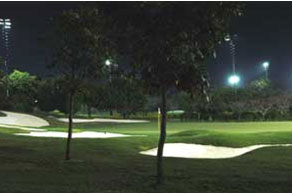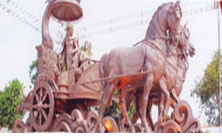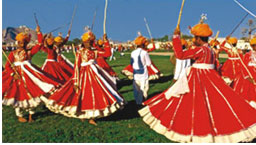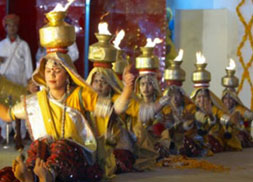|
Haryana (Hindi: हरियाणा, Urdu: ہریانہ, pronounced ; Punjabi: ਹਰਿਆਣਾ) is a state in India. Historically, it has been a part of the Kuru region in North India.The name Haryana is found mentioned in the 12th century AD by the apabhramsha writer Vibudh Shridha (VS 1189-1230). It is bordered by Punjab and Himachal Pradesh to the north, and by Rajasthan to the west and south. The river Yamuna defines its eastern border with Uttarakhand and Uttar Pradesh. Haryana also surrounds Delhi on three sides, forming the northern, western and southern borders of Delhi. Consequently, a large area of Haryana is included in the National Capital Region. The capital of the state is Chandigarh which is administered as a union territory and is also the capital of Punjab. The name Haryana means the Abode of God from Sanskrit Hari (the Hindu God Vishnu) and ayana (home), although it may also refer to the lush green landscape of the state (from Sanskrit harit meaning green).
Haryana was the cradle of the Indus Valle and Vedic Civilizations, both flourishing on the banks of the now lost Sarasvati  River. Several decisive battles were fought in the area, which shaped much of the history of India. These include the epic battle of Mahabharata at Kurukshetra (including the recital of the Bhagavad Gita by Krishna), and the three battles of Panipat. Haryana was administered as part of the Punjab province of British India, and was carved out on linguistic lines as India's 17th state in 1966. Haryana is now a leading contributor to the country's production of foodgrain and milk. Agriculture is the leading occupation for the residents of the state, the flat arable land irrigated by submersible pumps and an extensive canal system. Haryana contributed heavily to the Green Revolution that made India self-sufficient in food production in the 1960s. River. Several decisive battles were fought in the area, which shaped much of the history of India. These include the epic battle of Mahabharata at Kurukshetra (including the recital of the Bhagavad Gita by Krishna), and the three battles of Panipat. Haryana was administered as part of the Punjab province of British India, and was carved out on linguistic lines as India's 17th state in 1966. Haryana is now a leading contributor to the country's production of foodgrain and milk. Agriculture is the leading occupation for the residents of the state, the flat arable land irrigated by submersible pumps and an extensive canal system. Haryana contributed heavily to the Green Revolution that made India self-sufficient in food production in the 1960s.
Haryana is one of the wealthiest states of India and has the third highest per capita income in the country at Rs. 67,891, including the largest number of rural crorepatis in IndiaHaryana is also one of the most economically developed regions in South Asia and its agricultural and manufacturing industry has experienced sustained growth since 1970s Haryana is India's largest manufacturer of passenger cars, two-wheelers, and tractors. Since 2000, the state has emerged as the largest recipient of investment per capita in India The city of Gurgaon has rapidly emerged as a major hub for the informationtechnology and automobile industries. Gurgaon is home to Maruti Udyog Limited, India's largest automobile manufacturer, and Hero Honda Limited, the world's largest manufacturer of two-wheelers. Yamunanagar, Panipat, Panchkula and Faridabad are also industrial hubs, with the Panipat Refinery being the second largest refinery in South Asia. There are also long established steel, plywood, paper and textile industries in the state.
Major ethnic group in Haryana is of Jat people and Yaduvanshi Ahirs,Other ethnic groups are of Kambojs, Gujjars, Agarwals, Rors, Brahmins, Rajputs, Punjabis and Mali casteSainis Hindus are majority in Haryana and are about 90% of the population, Sikhs 6.2%, Muslims 4.05% and Christians 0.10%.
Ancient period
Manuscript illustration of the Battle of Kurukshetra.
Main articles:Indus Valley Civilization andVedic Civilization
Haryana was the outermost location of the ancient Indus Valley Civilization with centers such as Banawali and Rakhigarhi. The most extensive center, Rakhigarhi, is now a village in Hisar Distric. The site is dated to be over 5,000 years old. Evidence of paved roads, drainage system, large rainwater collection, storage system, terracotta brick, statue production, and skilled metal working (in both bronze and precious metals) has been uncovered.
Also the Vedic Civilization flourished on the banks of the now lost Sarasvati River. Several decisive battles were fought in the area, which shaped much of the history of India. These include the epic Battle of Kurukshetra described in the Mahabharata (including the recital of the Bhagavad Gita by Krishna) and the three battles of Panipat.
Medieval period
A 16th century painting depicting the First Battle of Panipat which established the Mughal Empire in India.
King Rao Tula Ram of Rewari[15]
After ousting the Huns, king Harshavardhana established his capital at Thanesar near Kurukshetra in the 7th century AD. After his death, the kingdom of his clansmen, the Pratiharas continued to rule over a vast region for quite a while from Harsha's adopted capital of Kannauj. The region remained strategically important for the rulers of North India even though Thanesar was no more central than Kannauj. Prithviraj Chauhan established forts at Tarori and Hansi in the 12th century. Muhammad Ghori conquered this area in the Second Battle of Tarain. Following his death, the Delhi Sultanate was established that ruled much of India for several centuries. The earliest reference to 'Hariana' occurs in a Sanskrit inscription dated 1328 AD kept in Delhi Museum, which refers to this region as The heaven on earth, indicating that it was fertile and relatively peaceful at that time. Firoz Shah Tughlaq established a fort at Hisar in 1354 to further fortify the region, and also constructed canals or rajwahas as they were referred to in the Indo-Persian historical texts.
The three famous battles of Panipat took place near the modern town of Panipat in Haryana. The first battle took place in 1526, where Babur, the ruler of Kabul, defeated Ibrahim Lodi of the Delhi Sultanate, through the use of field artillery. In the second battle of Panipat (5 November 1556), Akbar's forces defeated Samrat Hem Chandra Vikramaditya popularly called Hemu, who belonged to Rewari in Haryana and who had earlier won 22 battles, from Punjab to Bengal including two against Akbar's forces during 1553-1556 before acceeding to Delhi throne and establishing 'Hindu Raj' in North India on 7 October 1556. The Third Battle of Panipat was fought in 1761 between the Afghan warlord Ahmad Shah Abdali and the Marathas under Sadashivrao Bhau of Pune. Ahmad Shah won decisively, on 13 January 1761.
British period
The Second Anglo-Sikh War of 1848 to 1849 resulted in the Battle of Gujrat on 21 February 1849, at which the British defeated the Sikhs. As a result of this, on 2 April 1849 they annexed the Punjab as a new province of British India. This included most of Haryana, while the rest were ruled by the princely states of Loharu, Nabha, Jind and Patiala. During the Indian rebellion of 1857, several leaders from this region, including Rao Tula Ram, participated actively. People of Haryana took an active part in the Indian Independence movement.King Rao Tula Ram was one of the important leaders of the Indian Rebellion of 1857. Many battles were fought by the rulers of the states and by the farmers also, sometimes defeating the British army. Some most important fights were at Sonipat, Rohtak, Sirsa and Hissar. Later, leaders like Sir Chhotu Ram played an important role in the politics of the Punjab province.
Formation of Haryana
Haryana state was formed on 1 November 1966, on the recommendation of the Sardar Hukam Singh Parliamentary Committee. The formation of this committee was announced in the Parliament on 23 September 1965. On 23 April 1966, acting on the recommendation of the Hukam Singh Committee, the Indian government set up the Shah Commission under the chairmanship of Justice J. C. Shah, to divide and set up the boundaries of Punjab and Haryana giving consideration to the language spoken by the people. The commission gave its report on 31 May 1966. According to this report the then districts of Hissar, Mahendragarh, Gurgaon, Rohtak, and Karnal were to be a part of the new state of Haryana. Further, the tehsils of Jind (district Sangrur), Narwana (district Sangrur), Naraingarh, Ambala and Jagadhri were also to be included. The commission recommended that Tehsil Kharar (including Chandigarh) should be a part of Haryana.[16] Pt.Bhagwat Dayal Sharma, MLA from Yamunanagar became first Chief Minister of Haryana.
The city of Chandigarh, and a Punjabi-speaking area of district Rupnagar were made a Union Territory serving as the capital of both Punjab and Haryana. According to the Rajiv-Longowal Accord, Chandigarh was to be transferred to the state of Punjab in 1986, but the transfer was delayed and it has not been executed so far.
Pilgrim journey through Haryana.
The pilgrim's progress in Haryana is deeply rooted in devotion, legend and mythology. Though a number of temples dot the State, the focus of pilgrim movement in Haryana is concentrated in the 48-kosas of land that was once called Kurukshetra. The area covered 360 places of pilgrimage. Today, this area primarily covers centres of pilgrimage in modern Kurukshetra, Jyotisar, Thanesar and Pehowa towns. Another concentration of pilgrim centres can be seen around Chandigarh
Golf Tourism
Haryana - a state that blazed a trail of holiday
traditions, with its Tourism Policy, 2008 - could
well be called the land where perfect vacations begin. Tourist complexes of Haryana Tourism dot the five national Highways passing through the state. Helping you kick off your shoes and relax with pampered treatment. Haryana is vibrant and lively with all its natural beauty blended beautifully with folk culture and traditional ethos.
Haryana is also known for its world class courses and is immensely popular among the golfing fraternity. Haryana Tourism has taken the initiative to promote Golf Tourism in the state and taken golfing to new frontiers. The state has some truly amazing golf course, which offer you world-class ambience and facilities.
Adventure Tourism
Haryana Tourism catapulted into the arena of Adventure Sport with the forming if its Adventure Club in November ,1991. And Adventure sport had begun. The objective is to provide the young people with opportunities to realise their physical and mental potential by overcoming challenges and obstacles. Even as you read these words, some one somewhere in the state of Haryana will be venturing into our fascinating world of Adventure Sport. On braving a sheer rock-face; fighting to gain a foot hold in a bid to rock climb. At the Morni Hills near Chandigarh.
Come to Haryana Tourism for that Adrenal Rush
Haryana Tourism is organizing Soft Adventure Activities at its various tourist resorts, with the aim to inculcate leadership, team-work, sincerity, honesty, national integration, eco friendly and brotherhood qualities in the participating youth. All these activities are held under the guidance of atrained & qualified quide, following all safety measure. Some of the most undertaken activities are
· Trekking and Nature Trail
· Rock Climbing & Rappling
· Boating, Canoing and Kyaking
· River Crossing
· Target Practise
· Bird watching and Flora-Fauna Identification
· Green practices and Ecology Balance
· Rural Games
· Sustainable Tourism Practices.
Surajkund Craft mela
Ethnic n' Exotic, Exquisite n' Exclusive ...
A Kaleidoscope of Indian Handicrafts,
Handlooms and Folk Traditio
Come February'2011
Surajkund becomes alive with the rhythm and beats of folk dances and riot of colors.
Haryana- is the theme state this year for this year Mela.ns
Surajkund is the annual fair that showcases the finest handlooms, handicrafts, authentic fragrances & flavours of rich Indian cuisines. As winter turns briefly into spring, a caravan of more than 400 National and State awardee craftpersons from every corner of India wind their way to Surajkund. The craftpersons from SAARC Nations are also participating in the Surajkund Crafts Mela. At Surajkund Mela, the artisans' delicate hands create the most beautiful pieces which have fascinated many through ages !
25th Surajkund Crafts Mela offers a lot of Fun, Frolic,Entertainment and exclusive shopping. In the rural ambience, more than 400 craftperson will display and Demonstrate their finest crafts work that is set to capture your hearts. The authentic fragrances & flavours of rich Indian cuisines will kindle your taste buds. Tap your feet with the beats of enthralling folk dancers from the various parts of the country.
A fair to cherish and remember..... forever. 
HIGHLIGHTS
-
The Craftspersons from all over India, SAARC and other neighbouring countries would be selling the best of Handlooms and Handicrafts items.
-
Haryana the Theme State of this Year Mela known for rich culture and cusines.
-
A number of neihbouring countires would also be participating in thsi Mela.
-
Best of Cultural programmes organized jointly by Ministry of Culture,ICCR,New Delhi, Theme State Haryana and Cultural Affairs Department, Haryana & Haryana Kala Parishad.
-
Exporters Meet and Buyers Meet to be held at Surajkund Design Galleries with assistance of the DC Handlooms and DC Handicrafts.
-
Food Court with variety of Indian & SAARC countries Food. 
-
Amusement Zone with playful rides and swings.
Folk Dances by Schools/Colleges at Chaupal daily from 11 a.m. onwards
|